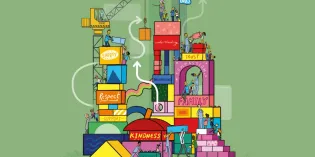
Contrary to the occupancy of hotels, inns and stables on Christmas Day, I've heard there'll be beds - although fewer mangers - on children's hospital wards. It's just a short time offer, because either side of the two or three key days the wards are rammed - elective surgery cancelled, patient transfers blocked, resources stretched, further inefficiencies mounting.
So what can we learn from the festive period?
Food: I like to ease my young patients into conversation at the start of a consultation and have recently been asking - "what's good about Christmas?" - mindful though that not everyone celebrates it - see 'Talking Turkey' by Benjamin Zepheniah1 . All responded (from toddlers to teenagers) and 68% answered "food!" - some without hesitation and pigs-in-blankets rated higher than turkey. Even though the amount spent per meal in hospital is higher than in schools it turns out food is still a reason to avoid hospital over the holidays.
Hospital Christmas Meal by marta a2
Mashed potato slopes
Gravy congeals. Mucky swamps.
Untouched feast. You sleep.
Family: None of the respondents identified a "glass of sherry for Santa" as key to proceedings. This might be a reason to avoid hospital visits, although I remember prescribing a small drink as a house officer on the adult wards of St John’s, Livingstone. Is that still a thing? What is still an issue is the rising complexity in mental health of parents 3 , including a significant rise in perinatal mental health referrals4 5 , often provoked by the demands and expectations of Christmas6 .
Gifts: Kids excel at giving one another, and also to grandparents, little parcels of genetic material that promote leaks, mess and misery. This is why they are given the flu vaccine7 . And now there's the RSV vaccine in the hope it will yield more hospital beds. This is also in the hope of reducing a "quademic" into a "tridemic", although many wonder if another virus will take its place?
We're four it now - flu admissions have rocketed by 350%, norovirus cases up by 86% and COVID and respiratory syncitial virus are rising...NHS boss Prof Sir Stephen Powis warned this could fast become a quademic.
Chimneys: When hoping for a visit from Santa why not stay on site of the largest chimney in the neighbourhood? Many hospitals still have these chimneys and since use of the incinerators ended back in the 1990s, Santa's backside has been safeguarded. In Wales, private companies now send an estimated 26% of the total hospital waste (600,000 tonnes across the UK) for high temperature incineration or alternative treatment8 9 . Fortunately, to avoid clouding Santa's approach, NHS Wales is leading on improvements in environmental sustainability8 .
Peace and quiet: I'm not sure a hospital would top any families' lists for these, but "safe and warm" might do for some. Life is unpredictable for all sorts of reasons, and we know children are disproportionately affected by the increasing levels of homelessness in Wales, with over 3,000 in temporary accommodation10 .
Seasonal sales: I'm told the surge in children's admissions on 27 December is the result of families holding out at home for as long as they can, rather than trying to avoid the rush to the shops. In comparison to the value of seasonal sales in the UK (an estimated £85 billion), reducing the number of young people not in education, employment or training to levels seen in the Netherlands could generate £69 billion in GDP11 . Healthcare can have a major impact on this if we get adolescent and young adult care right, reducing their admissions to adult wards and reducing their disproportionately long waits12 .
I guess the hospital admission conundrum is complex. However, my thoughts are with those who have the misfortune of being admitted over the festive period. And of course, we are all grateful to those who are there to care for them.
- A case study
-
A 13 year-old girl* identified early in October the importance of a party in the lead up to Christmas. It was, to some extent, a reunion with a couple of friends from her old school.
She was diagnosed with a rare form of cancer during the autumn four years previously and subsequently had a bone marrow transplant about a year after that. It was following this that she developed joint pains and was found to have avascular necrosis of her hips, significantly affecting her mobility and social contact. Her grandma also passed away one December and although generally withdrawn, the months of November to January were particularly challenging with especially poor school attendance. Christmas was not a happy time.
Her prognosis was favourable and engagement when face to face was reasonable. But she lacked critical motivation and struggled with anxiety when home and out and about. She was aware of working towards things of meaning to her and had various forms of talking therapy but this was the first concrete self-declared aspiration - to not show up at the party in her wheelchair and to be able to dance with her friends.
Needless to say, Cinderella went to the ball, but with the help of an occupational therapist, red crutches and practiced dance moves. School attendance also improved.
* This is a composite story taken from many young people seen over the years.
- 1www.youtube.com/watch?v=7Jj3gj7coOs
- 2www.booksie.com/711569-hospital-christmas-meal
- 3www.gov.uk/government/statistics/children-living-with-parents-in-emotional-distress-march-2022-update/methodology-and-supporting-information-children-living-with-parents-in-emotional-distress-march-2022-update
- 4www.england.nhs.uk/north-west/2024/05/03/record-numbers-of-women-accessing-perinatal-mental-health-support
- 5business.senedd.wales/documents/s64893/PMH%2029%20Welsh%20Government.pdf
- 6changemh.org/resources/christmas-and-mental-health/
- 7assets.publishing.service.gov.uk/media/66cdb14bb0bac21caec70907/UKHSA_12922_Protecting_your_child_against_flu_leaflet_04_WEB.pdf
- 8 a b https://www.nhsconfed.org/system/files/2024-11/how-the-nhs-in-wales-is-driving-improvements-in-environmental-sustainability--7114.pdf
- 9www.england.nhs.uk/estates/nhs-clinical-waste-strategy/
- 10www.bbc.co.uk/news/articles/cm27e2gn515o
- 11www.youthemployment.org.uk/tackling-youth-unemployment-could-generate-69bn-for-uk-economy/#:~:text=About%20the%20Youth%20Employment%20Group,inclusive%20employment%20for%20young%20people.&text=A%20limited%20number%20of%20case,enquire%20about%20a%20case%20study
- 12www.rcpch.ac.uk/resources/review-paediatric-waiting-times-wales










